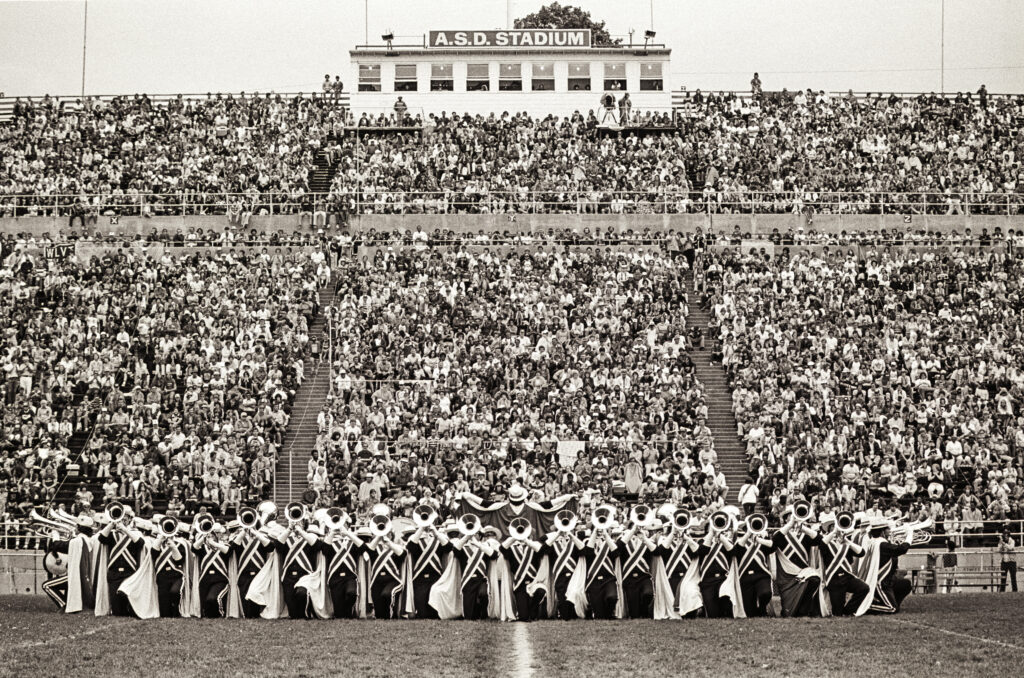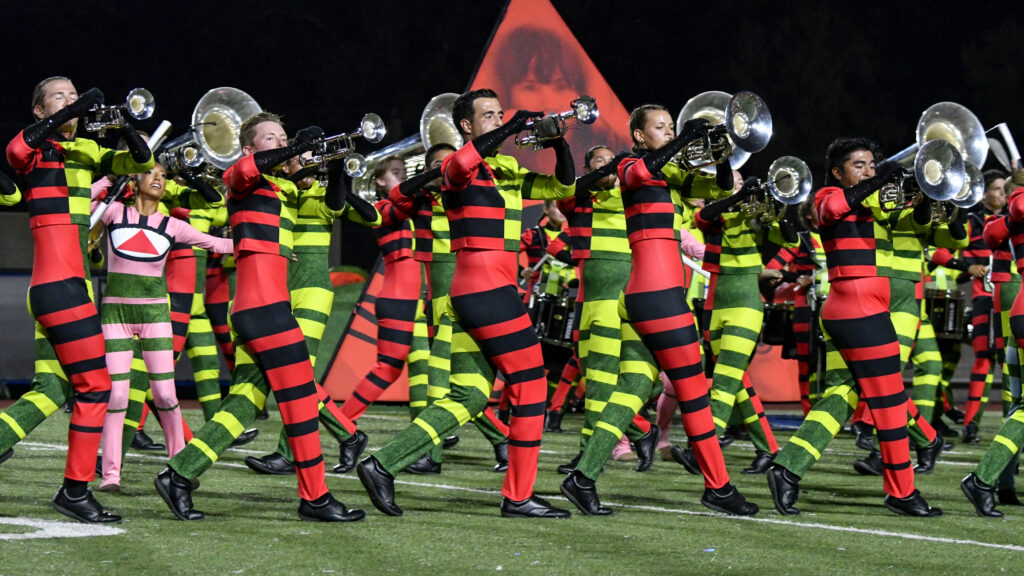The 1995 Drum Corps International World Championships were held in the same stadium as the 1990 events, except in the intervening years, Rich Stadium was renamed Ralph Wilson Stadium in honor of the founder of the NFL’s Buffalo Bills.
The Cavaliers won the corps’ second DCI title this year by winning all three nights of World Championship competition by increasingly larger margins.
Three corps earned their units’ highest placements up to that point in history. Glassmen finished in eighth, marking 10 years in a row that the corps moved up in placement each season. Colts finished in ninth place, the corps’ highest finish ever. And 11th-place Carolina Crown made the Division I (now World Class) Finals for the first time.
The end of World War II 50 years earlier was the inspiration for the 1995 productions of both the Bluecoats and Cadets of Bergen County. Bluecoats’ seventh-place “Homefront 1945” dealt more with the war effort that consumed all of America, while Cadets’ second-place “An American Quintet” focused more on the return home of the United States military veterans.
Cadets’ show was based entirely on the music of John Williams, arguably the most famous film composer to yet work in the medium. Williams is famed for writing many of the most revered film scores ever, including for the “Star Wars” franchise, “Jaws,” “Close Encounters of the Third Kind,” “Superman,” “ET,” the Indiana Jones movies, and too many others to mention.

The show began with the corps performing an arrangement of “The Reivers,” a 1969 film starring Steve McQueen that is one of Williams’ more obscure scores. The McQueen film, set in 1905 Mississippi, followed the exploits of young men who were continuously in trouble for their unruly ways. At the beginning of the Cadets’ opening segment, an American flag was raised up a pole next to a public monument as a mellophone played a bluesy solo without accompaniment.
Among the mid-century Americana that dotted the football field to set the theme were street lamps, sections of picket fence, trees, and scenes of Main Street USA. A park bench provided seating for two lovers. 1940s hairstyles on the female members of the color guard and period dress added a retro touch.
The second selection was Williams’ score to “Born on the 4th of July,” a film released in 1989 that is based on the 1976 autobiography of the same name by Vietnam War veteran and anti-war activist Ron Kovic. The movie was the middle film of director Oliver Stone’s Vietnam War tryptich, which included “Platoon” and “Heaven & Earth.”
This ballad showed the men in the color guard receiving their draft notices from a postman, before they moved to pick up military rifles and to take up sniper positions in a warlike setting. Some of the couples bid tearful farewells to each other before the males were sent overseas to fight a war from which they might not return.
The corps also utilized Williams’ “Blowing Off Steam” from the 1992 film “Far and Away.” Directed by Ron Howard, the movie explored two Irish immigrants seeking a better life in 1890s America. Williams’ symphonic score utilized Irish folk instruments as well as a traditional symphony orchestra.
“Swing, Swing, Swing,” from the movie “1941,” was John Williams’ take on Louis Prima’s swing classic, “Sign, Sing, Sing.” Steven Spielberg directed the comedic film that was inspired by the real panic that gripped the west coast after the attack on Pearl Harbor.
This piece represented the return home of the men from the battlefront, and consequently, jitterbug dancing ensued with the females they had left behind so many months earlier. A popular moment with audiences was when nine drummers ran around bass drums and field toms set on the field, playing on each different drum as they passed by and spun around.
Multiple drum sets on the field added to the rhythmic euphoria as the brass players marched to the front for an old-fashioned “park and blow.” Color guard members highlighted the moment visually by dancing atop and around assorted risers.
A small horn ensemble playing the melencholy theme to “Far and Away” was interupted by a drum roll-off as the rest of the corps formed a parade block to play the film’s “Land Race.”

The parade block was led by the male guard members twirling rifles in their military uniforms. Once breaking out of the parade block, the music halted as those color guard performers spun the rifles in a military fashion and the brass players and drummers pivoted in traditional close-order drill squads.
The block of corps members rotated as a drum major came to the front of the field with a 48-star American flag raised high in celebration. Once the brass section formed a company front to end the show, male members of the color guard, still in military garb, grabbed the flag and joined the drum major in re-creating the famed image of the U.S. Marines raising the flag atop Mt. Suribachi on the Pacific island of Iwo Jima in February of 1945, seven months prior to the end of World War II.
That image, later used to sculpt the Marine Corps War Memorial near Arlington National Cemetary, was an iconic way to end a show about one of the most iconic periods in American history.
1995 Overview

Michael Boo was a member of the Cavaliers from 1975-1977. He wrote about the drum corps activity for more than 35 years while serving as a staff writer for various Drum Corps International projects. During his lifetime Boo wrote for numerous other publications including an honors-winning book on the history of figure skating. He also was an accomplished composer. Boo passed away in 2020 and was inducted into the DCI Hall of Fame posthumously in 2021.





